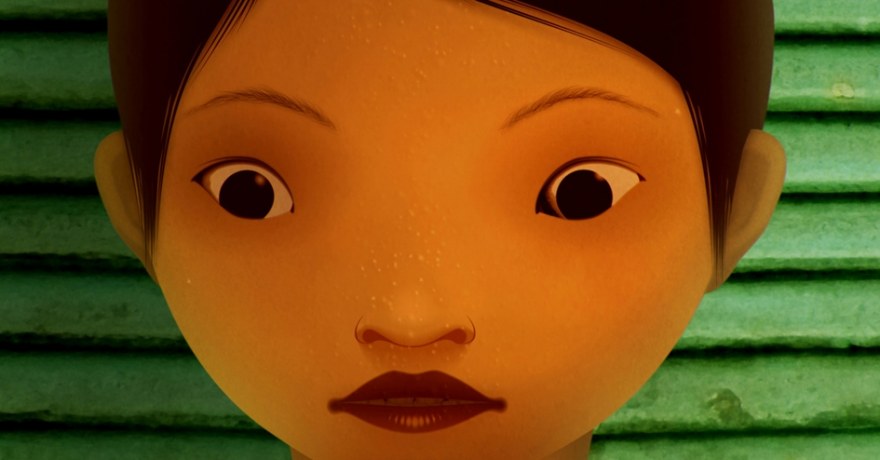Dinner with Café froid
Interview with Stéphanie Lansaque and François Leroy, directors of Café froid [Cold Coffee].
How did you conceive the animation in Café froid? Did you use models and/or 3D inserts? What techniques did you use?
Cold Coffee mixes video, photography and 2D digital animation (After Effects). We developed specific plug-ins that allowed us to mix these different techniques. The technical experimentation plays an integral part of our work.
In Café froid, you show how hopes and desires can be destroyed by the need to survive. Did you have it in mind to criticize a system where survival is only possible through work, or is more an observation of reality? Are there other possible systems?
The idea of this film comes first and foremost from an observation of reality. The need to survive as well as isolation and fear are the factors that drive our character to the extremes. Instead of a single factor, it is the accumulation that becomes unbearable.
Your film gives room to two particular animals: ants and rats. Why did you choose to focus on these animals?
Despite being a modern city, Saigon remains a tropical city inhabited by animals and particularly invasive species such as rats, ants and cockroaches. We build on the many phobias fed by these creatures. Our main character perceives them as intruders in her personal space.
Your film also addresses the passage into adulthood, with your main character suddenly having to take care of herself and thus having to deal with her fears and doubts. In your opinion, when does childhood truly end?
For us, there isn’t childhood on one side and adulthood on the other. We evolve throughout our lives. However, our main character is faced with such a drastic change that she cannot adapt.
In the film, you make a reference to Godzilla. Do you think this huge, destructive animal is an allegory for indiscriminate Nature, for humanity or its fears, or for something else entirely? Why did you want Godzilla to have a place in Café froid?
Godzilla is a nod to the horror film genre. But reality is far more terrifying than a cardboard monster. This scene is in fact the only moment that the character manages to sleep!
With this film, we tried to create a diffuse anxiety, without crystallizing the fear through a symbolic figure, but in basing the film on reality.
As in your past films, the setting of Café froid is an Asian environment. How does this environment inspire you more than others?
Our first trip to Vietnam in 2002 triggered our desire to make films. Since then, we live our lives between Paris, Hanoi and Saigon. Vietnam is part of our daily lives, and from this we have learned the language and customs.
In the mousetrap scene, you create an impression of height, of dimensions. How did you conceive this scene? Did you use real shots as a basis for your work?
Yes, indeed. We worked from real shots without using a story board. We used many subjective shots in order to be closer to the character and the character’s experience.
To add to the feeling of confinement, we played with the framing throughout the film. From the moment the mother dies, the frame progressively shrinks up to the most dramatic scene.
In Cold Coffee, there are long periods of silence. Why did you want to make this silence heard and how did you work on the soundtrack of the film overall?
The silence is never complete. Like the animals, outside noise infiltrates the house without a moment of relief for the young girl. However, the dialogue is sparse, which accentuates the character’s solitude.
In Café froid, you also address the question of violence and the contrast it creates with daily life. Why were you interested in this question and what inspired you to create the violent scene in this film?
For us, this violence is a part of daily life. If we try to avoid it, we sometimes find ourselves confronted by it all the same. Our character tries to repress it, but her emotions catch up with her.
Do you think that the short film is a good tool for calling the family unit into question, as well as the “mega” unit that is society?
The short film is an excellent tool in general. It allows us to address subjects and to call them into question in complete freedom, without any commercial constraints.
Café froid was either produced, co-produced or self-financed with French funds. Did you write the film with this “French” aspect in mind: in building the film’s context or in questioning certain notions?
Café froid was co-produced by Je Suis Bien Content and Arte France. Above all, French cinema is a space of freedom. The financing system allows a freedom of expression that attracts filmmakers from all over the world. We see this diversity in the future of French cinema.
.
Café froid is being shown in National Competition F2.
.
The film will also be shown in several other festivals such as Anima (5-14 February in Brussels), Tricky Women (2-6 March in Vienna), MECAL (9 March-3 April in Barcelona), Hong Kong International Film Festival (21 March-4 April in Hong Kong)…
Closer to home, you can catch the film at the Cinémathèque Française on Monday, 15 February or on TV on Friday, 12 February around midnight in the Court-Circuit Clermont special on Arte.








